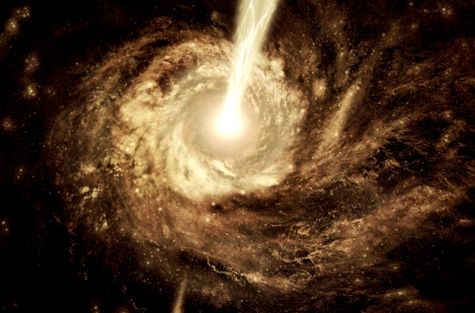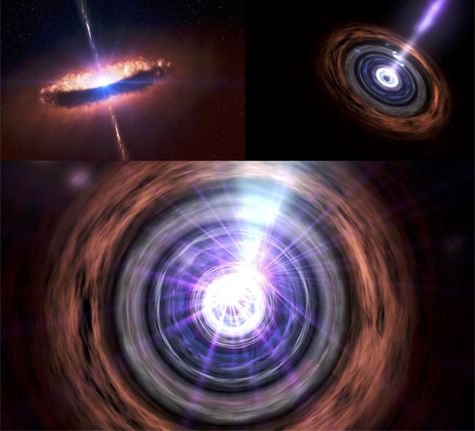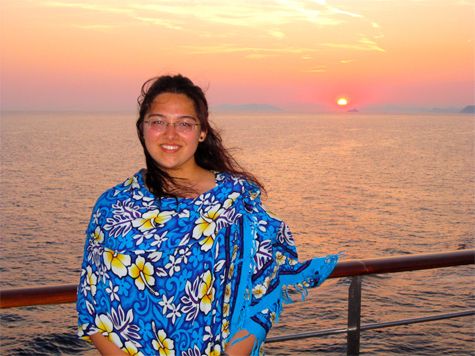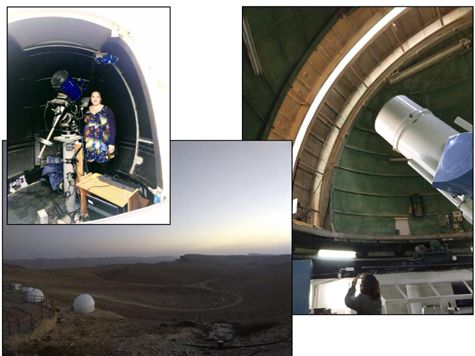Early Career Scientist Spotlight
Dr. Tiffany Lewis
Theoretical Astrophysicist
Astroparticle Physics Laboratory
What is your research focus?
My current work centers on theoretical models of blazar jets. A blazar is a jetted active galaxy with one jet pointed at earth, such that the light from the jet is strongly beamed, magnifying our view of the emission. Thus, blazars are ideal objects to study astrophysical particle acceleration. While we rarely, if ever, see particles from a blazar directly, the signatures of different processes, like shocks or stochastic acceleration, can be found in the details of the multi-wavelength emission spectrum. In order to probe observed data for those acceleration signatures, I develop a theoretical model of both the acceleration and emission in a self-consistent and intuitive manner. In this way, I explore particle acceleration in jets through the lens of spectral emission.

Credit: WallPaper-House
Did you always know that you wanted to be an Astrophysicist?
No, not at all. In high school, I got involved in Model UN to challenge myself because I was terrified of public speaking - incidentally a skill I now use in science. At that point I got very interested in diplomacy, but I was also starting to love physics. While majoring in physics in college, I planned to go to grad school for science policy, and I was taking a lot of classes in modern world history, US diplomatic history and media/publicity management. However, my physics major required a senior research project and I realized I really enjoy the environment of scientific research.
A large part of what I love about physics as a field is the strong tradition of mentorship and sense of community. Physics has a reputation for being a very difficult subject of study, and it can be, but we are never asked to do something before we’ve been prepared, and there are always people around to lend support and encouragement. I also find value in being that person for others, and I am perpetually inspired by my mentees.
What do you enjoy the most about your job?
I really enjoy the variety in my tasks. I found a career that combines and facilitates a lot of the activities I like to do and the independence to choose what my day will look like each day. I get to solve math problems through code development. I get to learn about the most powerful objects in the Universe, and advance knowledge. I get to talk to other people about science, advocacy, and how to do both of those things better. I also love that I get to travel to conferences to meet with scientists from around the world.

Credit: Simulation by NASA Goddard Space Flight Center Conceptual Image Lab
What skills are most useful to you in your work, and where did you develop those skills?
The practical skills I use most often are math and coding. I pursued math along the standard track from algebra and geometry to calculus and then differential equations. I took a computer science class in college, but actually learned to code during my undergraduate research project. I had a very patient mentor who would walk me through more advanced scientific codes one on one and gave me simple tasks to practice. I also took several courses in computational physics at the graduate level, but it was those lessons with my early mentor that led to my passion for computer programming work. Today, my theories are numerical, meaning they are expressed as an equation that gets solved by the code I write.
I’ve also built up a broad expertise in research by taking on a variety of projects in different subfields: exoplanet micro-lensing and transit observations, modeling tidal evolution of planetary bodies, time-dependent analysis of Kepler-observed cataclysmic variables, photometric observations of active galactic nucleus accretion disks, and blazar jet models. Each of these projects has built up in me a set of invaluable intuitions, perspectives, and practical skills that inform how I approach and solve the next one. As a theorist, a large part of what can make a new project interesting is whether it both advances the technical execution of the modeling and our ability to interpret the physical world through a comparison with observed data. A large part of the value I bring to a project is my physical intuition, which can only be acquired through time and experience.
View a larger version of this image.
Credit: Tiffany Lewis
Where do you see yourself in the near future?
I actually started working “at'' NASA Goddard at the end of 2020, well into the pandemic. As such, I have actually never seen my office. So, I hope someday soon I will get to experience the atmosphere of working at Goddard. In the meantime, I am busy with several projects, all looking at different aspects of modeling TXS0506+056, the only blazar that is associated with neutrino emission.
What is one of your favorite moments in your career so far?
My favorite moment in my career actually was not one of my own achievements. It was when I learned that some students I had mentored were about to graduate with their own PhDs. As proud as I am of my own dissertation work, it just felt like such a milestone to have worked with undergraduates who went on to complete their own. Mentoring is an extremely rewarding part of the role of a physicist.
What is a fun fact about you?
I used to live on a ship. When I was in college, I wanted to study abroad because I was interested in international policy, but I couldn’t decide where to go. I applied for the Semester at Sea program. Since Semester at Sea does not usually cater to science majors I had to go over the summer, to avoid missing math and physics curriculum during the regular semester. I visited 11 countries while learning about the history, art, and culture of each on the ship in between ports. I would love to go back as an instructor for a voyage or two, if they ever decide there’s room for an astrophysicist. Unfortunately, they no longer sail during the summer, meaning that science students like me would have a hard time finding the space in their schedule to go. Maybe one semester they’ll have a more STEM-centered voyage. Astrophysicists often work with collaborators and observing facilities around the world.

Credit: Tiffany Lewis
Biography
Home Town:
Rancho Santa Margarita, CA
Undergraduate Degree:
Bachelor of Science in Physics (minors in Math & History) from the George Washington University in Washington, DC
Post-graduate Degrees:
Master of Science in Applied & Engineering Physics, George Mason University in Fairfax, VA
PhD in Physics, George Mason University in Fairfax, VA


